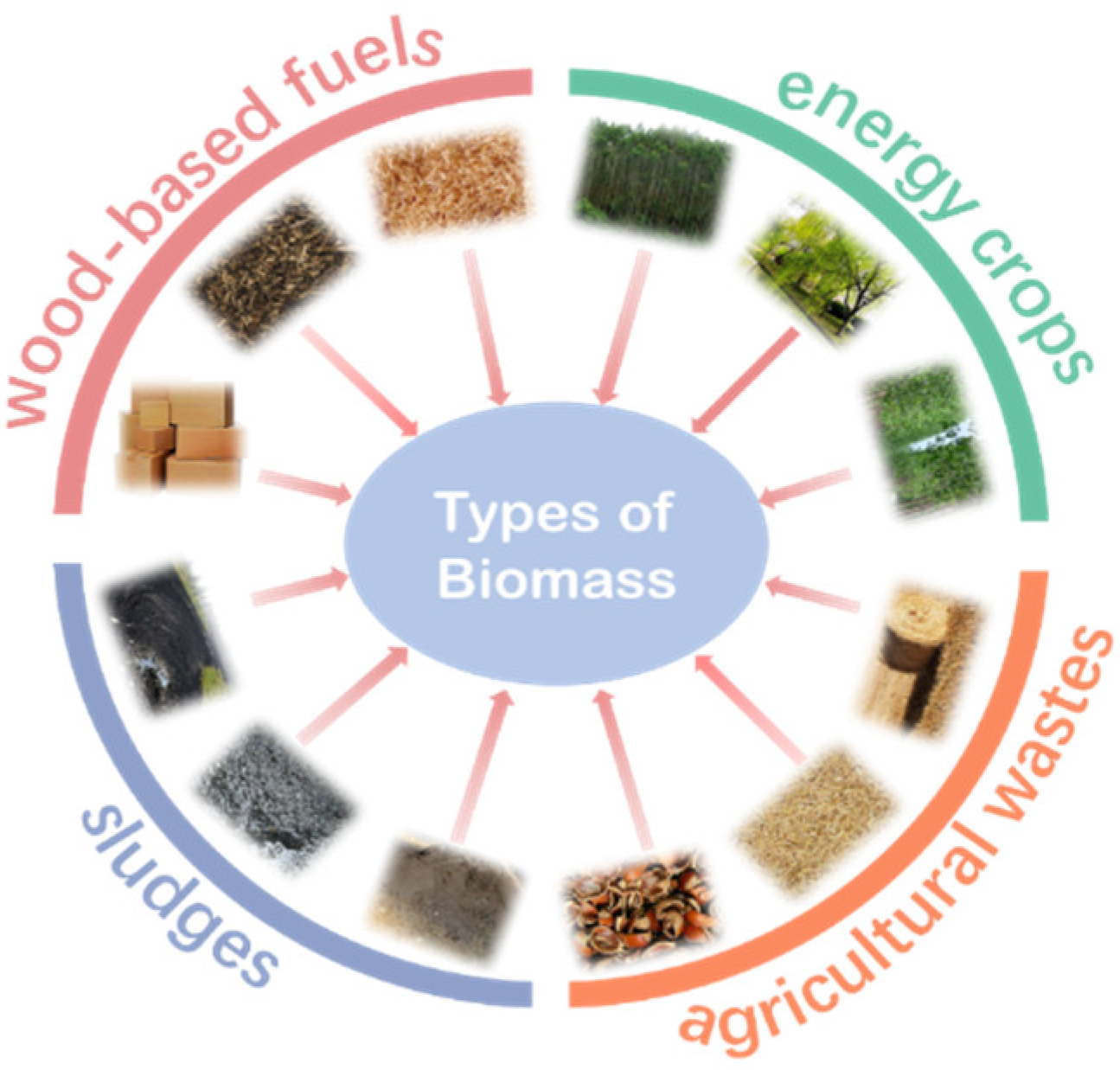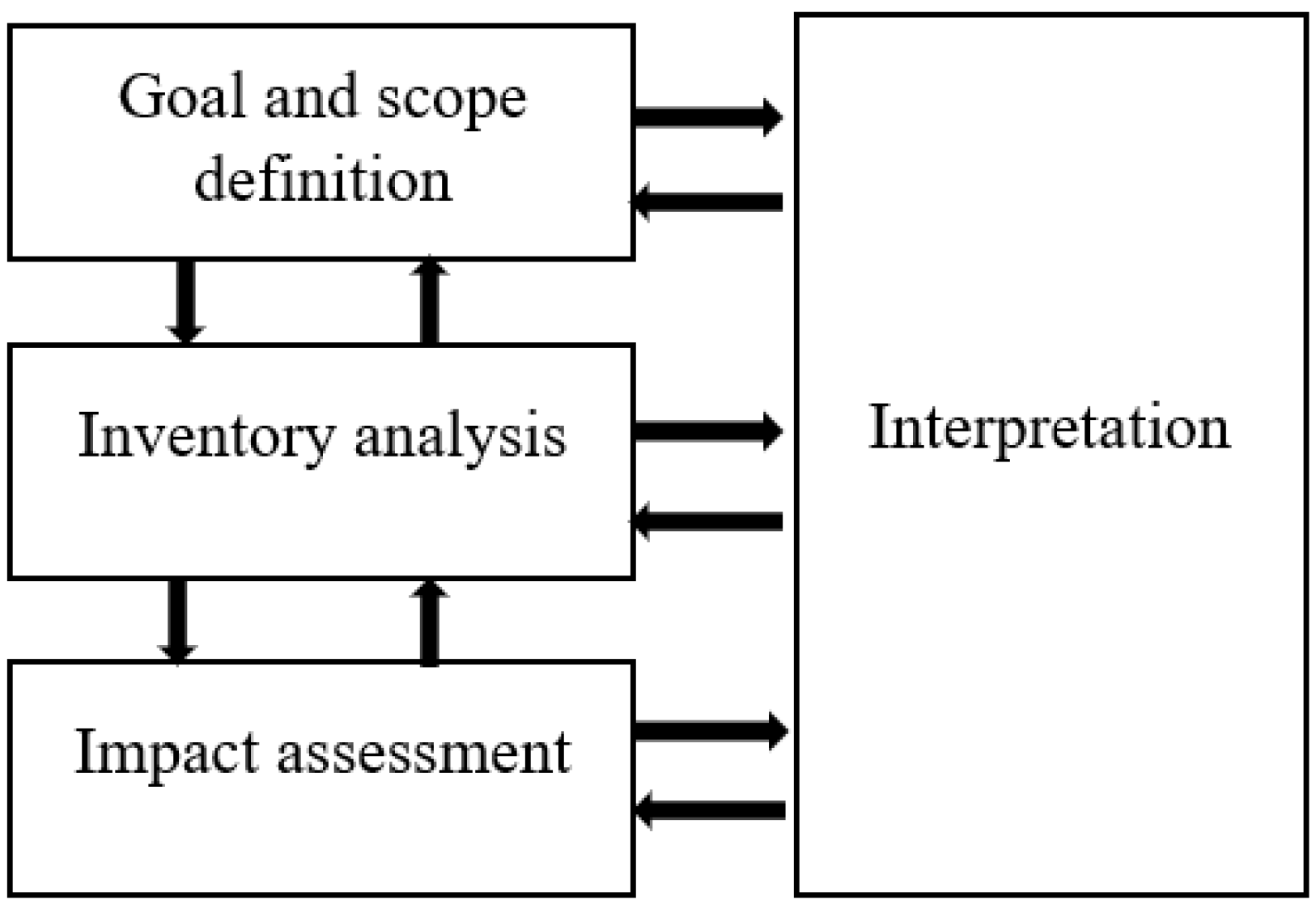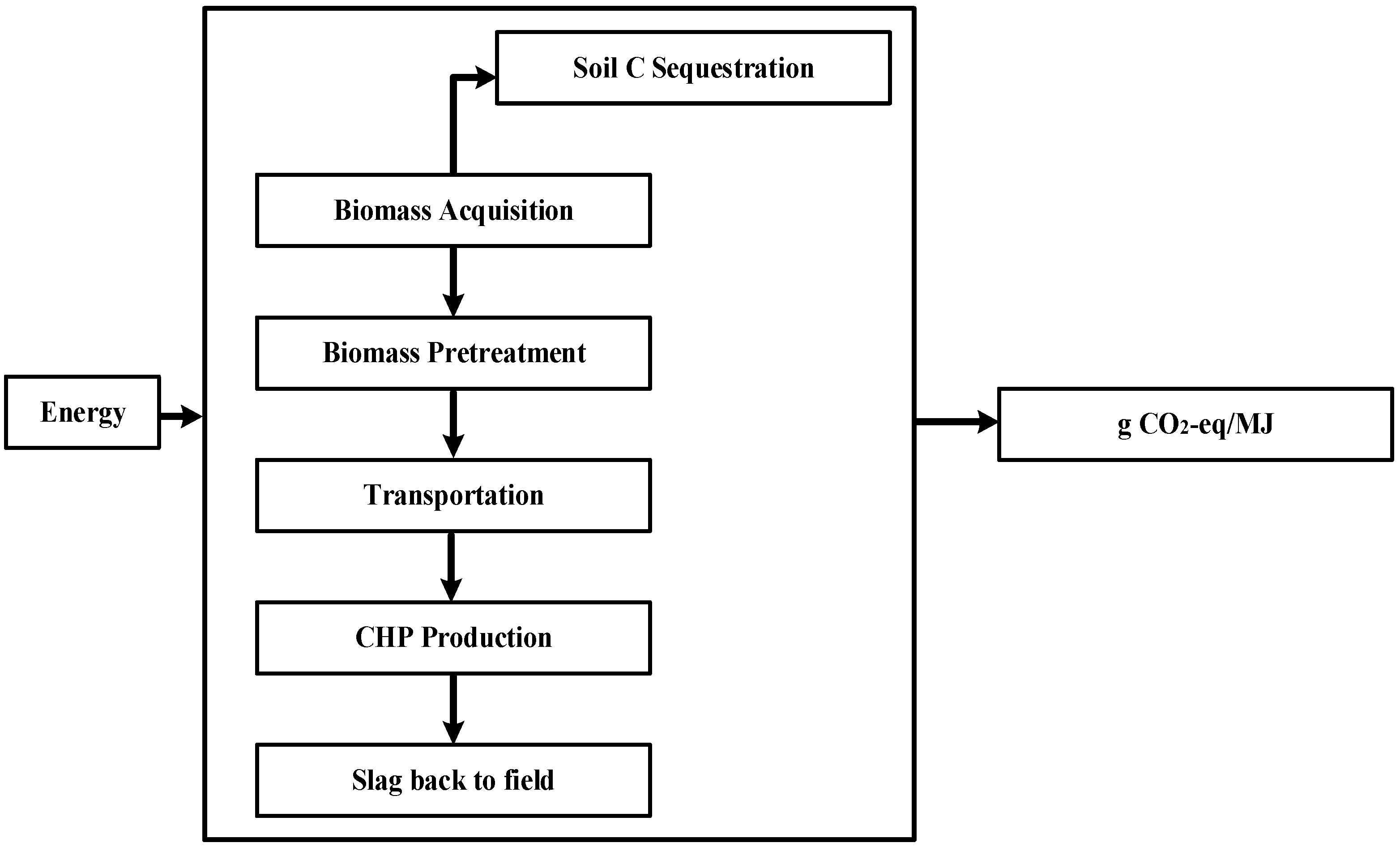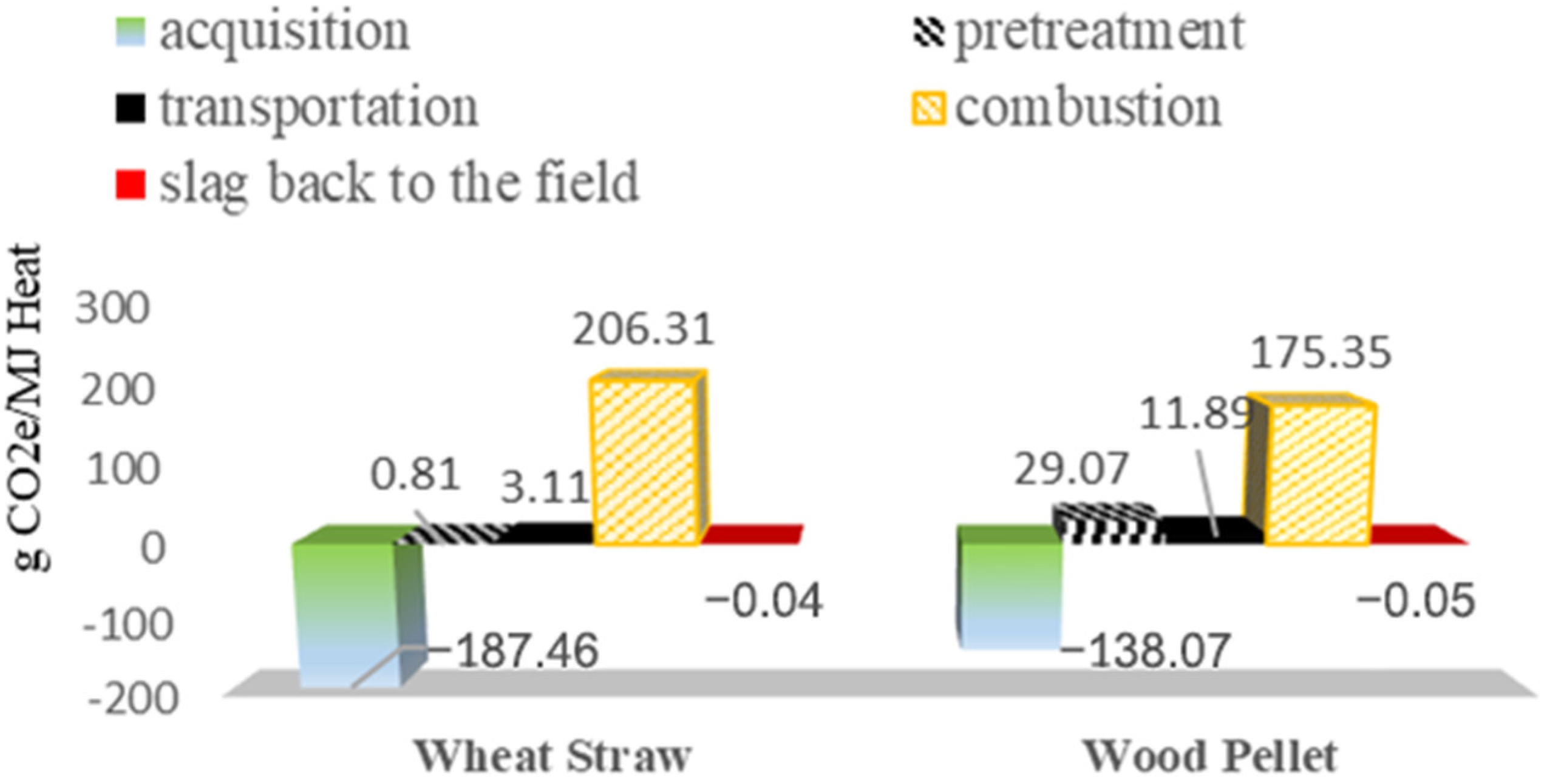Carbon Footprint Analysis for Biomass-Fueled Combined Heat and Power Station: A Case Study
Abstract
:1. Introduction
2. Materials and Methods
2.1. Case Study Overview
2.2. Goal and Scope
2.3. Life Cycle Inventory
- Acquisition: Currently, the Nordjylland Power Station burns bituminous coal, which is found near the Earth’s surface. The most common extraction method of bituminous coal is open-cast or strip mining. This acquisition stage involves heavy machinery such as power shovels, wheel excavators, dragline conveyors, and heavy-duty trucks. Other emissions contributors to the mining process are explosives to break through the surface. Wheat straw is assumed to be a byproduct of wheat production, and the raw material for wood-pellet production is considered to be collected from a sustainably managed natural forest.
- Pretreatment: For the wheat straw to be ready and suitable burned in the supercritical boiler, it must be piled and organized into a manageable size for the boiler. This process involves grouping the wheat straw into bales and handling the bales into a machine that feeds the boiler.
- Transportation: The coal and wheat straw are assumed to be transported over a distance of 200 km, from the pretreatment plant to the CHP plant. The transportation is assumed to start from the pretreatment/storage site by 10-wheel truck, with 15 tonnes of carrying capacity (100% loading) and 0% loading on the return trip. The average freight truck is assumed to emit 0.1618 kg of carbon dioxide equivalent (CO2e) per tonne-mile [28]. The wood pellets are assumed to be imported by freight ship from Latvia, which is 525 nautical miles away from Denmark. The commercial ship is assumed to emit 0.0418 kg of CO2e per tonne-nautical mile [29]. The total required coal or biomass mass is calculated based on the CHP plant capacity, fuel heating value, working hours, and operating efficiency. The total emissions are calculated by multiplying the emission factors by the distance and the weight.
- Combustion: Prior to combustion, coal is crushed into fine dust at silos on site. Then a mixture of air and coal is blown into the burner, where the combustion takes place in the boiler furnace at a temperature as high as 1800˚C. The biomass is fed into the boiler, and the steam from the incinerated boiling water is used for district heating. The coal and biomass-powered CHP plant efficiency is approximately 90% [30], indicating that 90% of the primary energy supplied from coal or biomass feedstock is converted to electricity and heat. The power-to-heat ratio in existing CHP systems is 0.75.
- Slag back to the field: Slag, a glass-like by-product left over after combustion, is assumed to be recycled and reused as fertilizer because of its nutrient value. The presence of heavy and toxic metals makes ash valueless. Slag from the burning of wheat straw and wood pellets is found to be 54 kg/t and 67 kg/t in the dry base, respectively [32].
2.4. Impact Assessment and Interpretation
2.5. Assumptions and Limitations
3. Results
4. Discussions
5. Conclusions
Author Contributions
Funding
Acknowledgments
Conflicts of Interest
References
- Jørgensen, M.S.; Andersen, B.H. The Controversies over bioenergy in denmark:’bio’is not the same as ‘sustainable’. Environ. Eng. Manag. J. 2012, 11, 2101–2119. [Google Scholar] [CrossRef]
- Monast, J.J.; Adair, S.K. A Triple Bottom Line for Electric Utility Regulation: Aligning State-Level Energy, Environmental, and Consumer Protection Goals. Colum. J. Envtl. L. 2013, 38, 1. [Google Scholar]
- Fernando, R. Cofiring high ratios of biomass with coal. IEA Clean Coal Cent. 2012, 300, 194. [Google Scholar]
- IEA Bioenergy Annual Report 2011. Available online: https://www.ieabioenergy.com/blog/publications/annual-report-2011/ (accessed on 29 July 2022).
- Meibom, P.; Hilger, K.B.; Madsen, H.; Vinther, D. Energy comes together in Denmark: The key to a future fossil-free Danish power system. IEEE Power Energy Mag. 2013, 11, 46–55. [Google Scholar] [CrossRef]
- Zheng, Y.; Jenkins, B.M.; Kornbluth, K.; Kendall, A.; Træholt, C. Optimal design and operating strategies for a biomass-fueled combined heat and power system with energy storage. Energy 2018, 155, 620–629. [Google Scholar] [CrossRef]
- Gregg, J.S.; Bolwig, S.; Solér, O.; Vejlgaard, L.; Gundersen, S.H.; Grohnheit, P.E.; Karlsson, K.B. Experiences with Biomass in Denmark. Department of Management Engineering; Technical University of Denmark: Roskilde, Denmark, 2014. [Google Scholar]
- Bentsen, N.S.; Nilsson, D.; Larsen, S. Agricultural residues for energy—A case study on the influence of resource availability, economy and policy on the use of straw for energy in Denmark and Sweden. Biomass Bioenergy 2018, 108, 278–288. [Google Scholar] [CrossRef]
- Danish Energy Agency (DEA) 2014, Energy Statistics 2012. Available online: https://rucforsk.ruc.dk/ws/portalfiles/portal/81004830/Experiences_with_biomass_in_Denmark.pdf (accessed on 20 May 2022).
- Curran, M.A. Life Cycle Assessment Handbook: A Guide for Environmentally Sustainable Products; John Wiley & Sons: Hoboken, NJ, USA, 2012. [Google Scholar]
- Tagliaferri, C.; Evangelisti, S.; Clift, R.; Lettieri, P. Life cycle assessment of a biomass CHP plant in UK: The Heathrow energy centre case. Chem. Eng. Res. Des. 2018, 133, 210–221. [Google Scholar] [CrossRef]
- D’Imporzano, G.; Pilu, R.; Corno, L.; Adani, F. Arundo donax L. can substitute traditional energy crops for more efficient, environmentally-friendly production of biogas: A Life Cycle Assessment approach. Bioresour. Technol. 2018, 267, 249–256. [Google Scholar] [CrossRef] [PubMed]
- Kimming, M.; Sundberg, C.; Nordberg, Å.; Baky, A.; Bernesson, S.; Norén, O.; Hansson, P.A. Biomass from agriculture in small-scale combined heat and power plants—A comparative life cycle assessment. Biomass Bioenergy 2011, 35, 1572–1581. [Google Scholar] [CrossRef]
- Parajuli, R.; Løkke, S.; Østergaard, P.A.; Knudsen, M.T.; Schmidt, J.H.; Dalgaard, T. Life Cycle Assessment of district heat production in a straw fired CHP plant. Biomass Bioenergy 2014, 68, 115–134. [Google Scholar] [CrossRef]
- Adhikari, S.; Nam, H.; Chakraborty, J.P. Conversion of solid wastes to fuels and chemicals through pyrolysis. Waste Biorefinery 2018, 239–263. [Google Scholar]
- Balafkandeh, S.; Zare, V.; Gholamian, E. Multi-objective optimization of a tri-generation system based on biomass gasification/digestion combined with S-CO2 cycle and absorption chiller. Energy Convers. Manag. 2019, 200, 112057. [Google Scholar] [CrossRef]
- Roedl, A. Production and energetic utilization of wood from short rotation coppice—A life cycle assessment. Int. J. Life Cycle Assess. 2010, 15, 567–578. [Google Scholar] [CrossRef]
- Benetto, E.; Popovici, E.C.; Rousseaux, P.; Blondin, J. Life cycle assessment of fossil CO2 emissions reduction scenarios in coal-biomass based electricity production. Energy Convers. Manag. 2004, 45, 3053–3074. [Google Scholar] [CrossRef]
- Judl, J.; Koskela, S.; Korpela, T.; Karvosenoja, N.; Häyrinen, A.; Rantsi, J. Net environmental impacts of low-share wood pellet co-combustion in an existing coal-fired CHP (combined heat and power) production in Helsinki, Finland. Energy 2014, 77, 844–851. [Google Scholar] [CrossRef]
- Spitzley, D.V.; Keoleian, G.A. Life Cycle Environmental and Economic Assessment of Willow Biomass Electricity: A Comparison with other Renewable and Non-Renewable Sources; University of Michigan: Ann Arbor, MI, USA, 2005. [Google Scholar]
- Yan, Y.; Zhang, H.; Meng, J.; Long, Y.; Zhou, X.; Li, Z.; Liang, Y. Carbon footprint in building distributed energy system: An optimization-based feasibility analysis for potential emission reduction. J. Clean. Prod. 2019, 239, 117990. [Google Scholar] [CrossRef]
- McDonald, J.D.; Zielinska, B.; Fujita, E.M.; Sagebiel, J.C.; Chow, J.C.; Watson, J.G. Fine particle and gaseous emission rates from residential wood combustion. Environ. Sci. Technol. 2000, 34, 2080–2091. [Google Scholar] [CrossRef]
- Sandin, G.; Clancy, G.; Heimersson, S.; Peters, G.M.; Svanström, M.; Ten Hoeve, M. Making the most of LCA in technical inter-organisational R&D projects. J. Clean. Prod. 2014, 70, 97–104. [Google Scholar]
- Fthenakis, V.; Frischknecht, R.; Raugei, M.; Kim, H.C.; Alsema, E.; Held, M.; de Wild-Scholten, M. Methodology guidelines on life cycle assessment of photovoltaic electricity. IEA PVPS Task 2011, 12. Available online: https://iea-pvps.org/wp-content/uploads/2020/01/rep12_11.pdf (accessed on 20 May 2022).
- Kelly, K.A.; McManus, M.C.; Hammond, G.P. An energy and carbon life cycle assessment of industrial CHP (combined heat and power) in the context of a low carbon UK. Energy 2014, 77, 812–821. [Google Scholar] [CrossRef] [Green Version]
- Du, C.M.; Gao, X.; Ueda, S.; Kitamura, S.Y. Recovery of phosphorus from modified steelmaking slag with high P2O5 content via leaching and precipitation. Isij Int. 2018, 58, 833–841. [Google Scholar] [CrossRef] [Green Version]
- Cherubini, F.; Peters, G.P.; Berntsen, T.; Strømman, A.H.; Hertwich, E. CO2 emissions from biomass combustion for bioenergy: Atmospheric decay and contribution to global warming. GCB Bioenergy 2011, 3, 413–426. [Google Scholar] [CrossRef] [Green Version]
- Clean Air Innovation. Available online: shorturl.at/jvER1 (accessed on 20 October 2020).
- Calculation Methods. Available online: shorturl.at/awK27 (accessed on 6 October 2021).
- Braimakis, K.; Magiri-Skouloudi, D.; Grimekis, D.; Karellas, S. Εnergy-exergy analysis of ultra-supercritical biomass-fuelled steam power plants for industrial CHP, district heating and cooling. Renew. Energy 2020, 154, 252–269. [Google Scholar] [CrossRef]
- Tsalidis, G.A.; Discha, F.E.; Korevaar, G.; Haije, W.; de Jong, W.; Kiel, J. An LCA-based evaluation of biomass to transportation fuel production and utilization pathways in a large port’s context. Int. J. Energy Environ. Eng. 2017, 8, 175–187. [Google Scholar] [CrossRef]
- Nielsen, P. “Heat and Power Production from Straw” Thermochemical Biomass Conversion; Springer: Berlin/Heidelberg, Germany, 2004. [Google Scholar]
- Heath, A.; Paine, K.; McManus, M. Minimising the global warming potential of clay based geopolymers. J. Clean. Prod. 2014, 78, 75–83. [Google Scholar] [CrossRef] [Green Version]
- Solomon, S. The physical science basis: Contribution of Working Group I to the fourth assessment report of the Intergovernmental Panel on Climate Change. Intergov. Panel Clim. Change (IPCC) Clim. Change 2007, 996, 2007. [Google Scholar]
- Ito, T.; Watanabe, T.; Ishibashi, Y.; Tsukada, T.; Monai, T.; Nii, S.; Yokoyama, R. A high-efficiency, high-quality power supply implemented with a lean-burn gas engine and a power storage device. In Proceedings of the IEEE PES General Meeting, Minneapolis, MN, USA, 30 September 2010; pp. 1–7. [Google Scholar]
- Havukainen, J.; Nguyen, M.T.; Väisänen, S.; Horttanainen, M. Life cycle assessment of small-scale combined heat and power plant: Environmental impacts of different forest biofuels and replacing district heat produced from natural gas. J. Clean. Prod. 2018, 172, 837–846. [Google Scholar] [CrossRef]
- Thakur, A.; Canter, C.E.; Kumar, A. Life-cycle energy and emission analysis of power generation from forest biomass. Appl. Energy 2014, 128, 246–253. [Google Scholar] [CrossRef]
- Guest, G.; Bright, R.M.; Cherubini, F. Life cycle assessment of biomass-based combined heat and power plants: Centralized versus decentralized deployment strategies. J. Ind. Ecol. 2011, 15, 908–921. [Google Scholar] [CrossRef]




| Biomass | Domestic Production | Imports | Total |
|---|---|---|---|
| Wood pellets | 1.7 | 31.8 | 33.5 |
| Wood chips | 12 | 6.2 | 18.2 |
| Straw | 17.5 | 0 | 17.5 |
| Biofuels | 2.5 | 7 | 9.5 |
| Biogas | 4.4 | 0 | 4.4 |
| Total | 79.2 | 48.3 | 127.5 |
| Coal | Wheat Straw | Wood Pellets | |
|---|---|---|---|
| Moisture | 8.0 | 6.8 | 5.9 |
| Ash | 14.2 | 11.7 | 1.0 |
| Carbon | 66.5 | 40.7 | 46.6 |
| Hydrogen | 3.8 | 5.5 | 5.8 |
| Nitrogen | 1.6 | 0.6 | 0.2 |
| Sulfur | 0.5 | 0.1 | 0.8 |
| Oxygen | 5.5 | 34.6 | 39.7 |
| LHV | 25.2 | 14.0 | 17.6 |
| Process | g CO2e/MJ Heat |
|---|---|
| Coal | |
| mining | 21.78 |
| transportation | 1.73 |
| combustion | 93.5 |
| Total | 117.01 (CO2: 80.95 g, CH4: 0.11 g, N2O: 0.09 g) |
| Wheat Straw | |
| acquisition | −187.46 |
| baling and handling | 0.73 |
| chopping | 0.08 |
| transportation | 3.11 |
| combustion | 206.31 |
| slag back to the field | −0.04 |
| Total | 22.73 (CO2: 9.15 g, CH4: 0.04 g, N2O: 0.03 g) |
| Wood Pellets | |
| acquisition | −138.07 |
| drying | 29.04 |
| chopping | 0.03 |
| transportation | 11.89 |
| combustion | 175.35 |
| slag back to the field | −0.05 |
| Total | 78.19 (CO2: 44.70 g, CH4: 0.16 g, N2O: 0.07 g) |
Publisher’s Note: MDPI stays neutral with regard to jurisdictional claims in published maps and institutional affiliations. |
© 2022 by the authors. Licensee MDPI, Basel, Switzerland. This article is an open access article distributed under the terms and conditions of the Creative Commons Attribution (CC BY) license (https://creativecommons.org/licenses/by/4.0/).
Share and Cite
Zheng, Y.; Liu, C.; Zhu, J.; Sang, Y.; Wang, J.; Zhao, W.; Zhuang, M. Carbon Footprint Analysis for Biomass-Fueled Combined Heat and Power Station: A Case Study. Agriculture 2022, 12, 1146. https://doi.org/10.3390/agriculture12081146
Zheng Y, Liu C, Zhu J, Sang Y, Wang J, Zhao W, Zhuang M. Carbon Footprint Analysis for Biomass-Fueled Combined Heat and Power Station: A Case Study. Agriculture. 2022; 12(8):1146. https://doi.org/10.3390/agriculture12081146
Chicago/Turabian StyleZheng, Yingying, Chang Liu, Jie Zhu, Yuanrui Sang, Jinglong Wang, Wenjing Zhao, and Minghao Zhuang. 2022. "Carbon Footprint Analysis for Biomass-Fueled Combined Heat and Power Station: A Case Study" Agriculture 12, no. 8: 1146. https://doi.org/10.3390/agriculture12081146
APA StyleZheng, Y., Liu, C., Zhu, J., Sang, Y., Wang, J., Zhao, W., & Zhuang, M. (2022). Carbon Footprint Analysis for Biomass-Fueled Combined Heat and Power Station: A Case Study. Agriculture, 12(8), 1146. https://doi.org/10.3390/agriculture12081146





